
Browse an alphabetical list of photographs. These historical images portray people, places, and events before, during, and after World War II and the Holocaust.
<< Previous | Displaying results 801-850 of 2641 for "Photo" | Next >>
General Dwight D. Eisenhower (third from left) views the charred remains of inmates of the Ohrdruf camp. Ohrdruf, Germany, April 12, 1945.
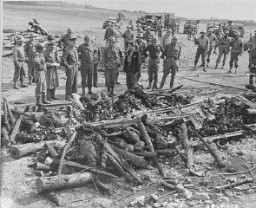
General Dwight D. Eisenhower (center, right) views the corpses of victims of the Ohrdruf camp. Germany, April 12, 1945.
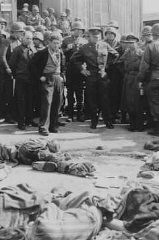
Best friends Ejanga Egiomue (left) and Magdalene Garber (right) on an outing in Berlin, Germany during World War II (likely 1941-1942). Magdalene stayed in Germany, but Ejanga fled to Denmark in 1944. Both women survived the war and stayed in contact with each other, exchanging letters and correspondence well into the 1990s. Magdalene (“Leni”) Garber was born in January, 1919 in Germany. Her parents were Joseph Garber, a Togolese man, and Johanna Maychrzak, a white German woman. Magdalene grew up in…
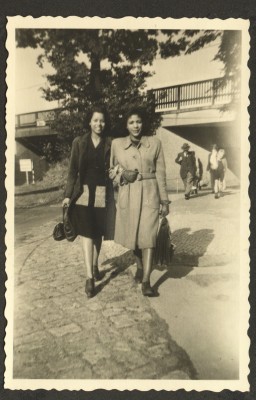
An elderly Jewish woman wears the compulsory yellow badge in the Riga ghetto. Latvia, between 1941 and 1944.
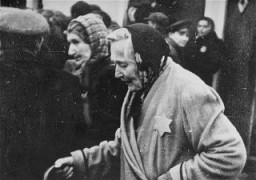
Election officers count votes late into the night after the second round of the 2006 presidential and provincial elections in Bunia, Ituri, Democratic Republic of the Congo.

Poster: "Greater Germany: Yes on 10 April" (1938). This election poster emphasizes the message of jumping on the Nazi political bandwagon, as represented by the hands raised in a unified Nazi salute. Nazi propaganda frequently stressed the power of a mass movement to propel the country forward, subtly underscored by the upward angle of the hands. This poster typifies the propaganda strategy of using simple confident slogans, with bold graphics often using the characteristic Nazi colors of red, black, and…
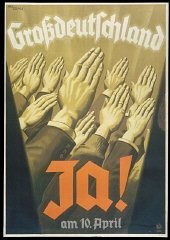
Eliahu Dobkin of the Jewish Agency (left) and Henrietta Szold, founder of the Hadassah Women's Zionist Organization (second from left), await the arrival of the "Tehran Children." Atlit, Palestine, February 18, 1943.
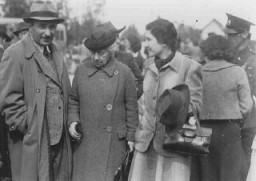
Elie Wiesel became Founding Chairman of the United States Holocaust Memorial Council in 1980. Here, he speaks at a ceremony held during the Tribute to Holocaust Survivors, one of the Museum's tenth anniversary events. Flags of US Army liberating divisions form the backdrop to the ceremony. Washington, DC, November 2003.
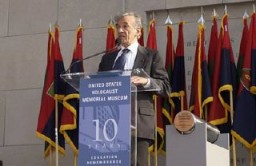
Elie Wiesel with his wife Marion and President Ion Iliescu in Sighet following the presentation of the Final Report of the International Commission on the Holocaust in Romania. Learn more about Romania facing its past.
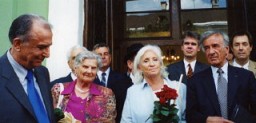
Elie Wiesel speaks at the Faith in Humankind conference, held before the opening of the United States Holocaust Memorial Museum, on September 18–19, 1984, in Washington, DC.
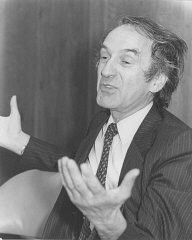
Elie Wiesel speaks at the Days of Remembrance ceremony, Washington, DC, 2001.
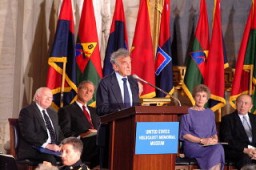
Elie Wiesel speaks at the Days of Remembrance ceremony, Washington, DC, 2002.
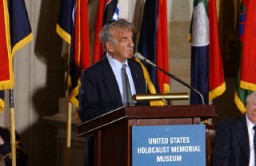
Elie Wiesel speaks at the Faith in Humankind conference, held several years before the opening of the United States Holocaust Memorial Museum. September 18–19, 1984, in Washington, DC.
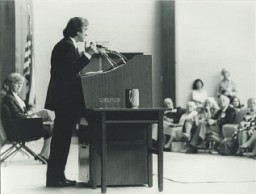
Elie Wiesel (right) with his wife and son during the Faith in Humankind conference, held several years before the opening of the United States Holocaust Memorial Museum. September 18–19, 1984, in Washington, DC.
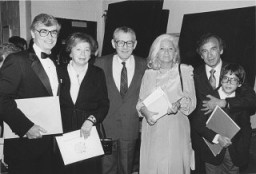
Elie Wiesel with President Ion Iliescu in Sighet following the presentation of the Final Report of the International Commission on the Holocaust in Romania.
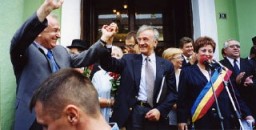
Elisabeth, Hans Werner, and Paul Gerhard Kusserow. Because they were the children of Jehovah's Witnesses, all three were forcibly removed from school on March 7, 1939, and kept separated from their family, which was accused of spiritual and moral neglect, until their liberation in April 1945. This photograph was taken at the Kusserow home in Bad Lippspringe, 1936-1939.
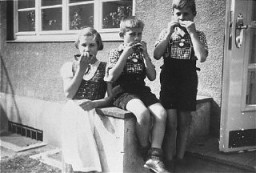
Elsa Eisner, marked with a Jewish badge, walks down a street in Prague. She, her mother, twin sister and other members of the family were deported to Auschwitz in July 1942. Prague, Czechoslovakia, ca. 1941.
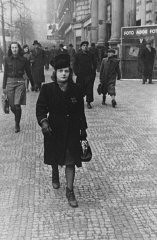
Four emaciated survivors sit outside in the newly liberated Ebensee concentration camp. Photograph taken by Signal Corps photographer J Malan Heslop. Ebensee, Austria, May 8, 1945.
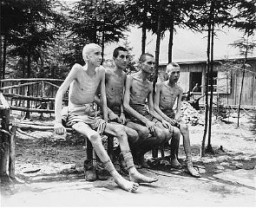
The American Jewish Congress holds an emergency session following the Nazi rise to power and subsequent anti-Jewish measures. United States, May 1933.
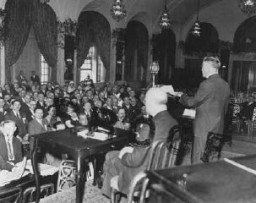
Emmi G., a 16-year-old housemaid diagnosed as schizophrenic. She was sterilized and sent to the Meseritz-Obrawalde euthanasia center where she was killed with an overdose of tranquilizers on December 7, 1942. Place and date uncertain.
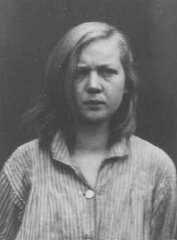
Entrance to the public baths in Wannsee with a sign stating, "Entrance to Jews is forbidden." Berlin, Germany, 1935.
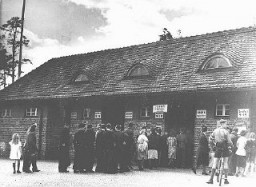
View of the entrance to Oskar Schindler's enamel works in Zablocie, a suburb of Krakow. Poland, 1939-1944.
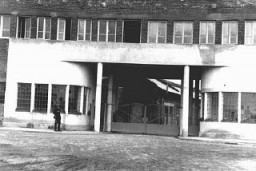
Entrance to the Breendonk internment camp. Breendonk, Belgium, 1940-1944.
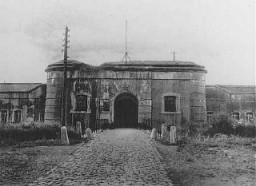
The entrance to the gas chamber in Auschwitz I, where Zyklon B was tested on Soviet prisoners of war. The building in the background is a hospital for SS members. Auschwitz, Poland, date uncertain.
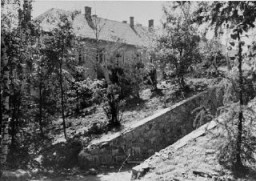
View of the entrance to the Plaszow camp. Plaszow, Poland, 1943-1944.
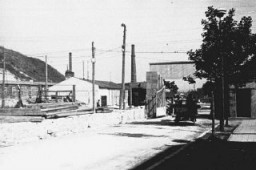
Entrance to the Ploetzensee prison. At Ploetzensee, the Nazis executed hundreds of Germans for opposition to Hitler, including many of the participants in the July 20, 1944, plot to kill Hitler. Berlin, Germany, postwar.
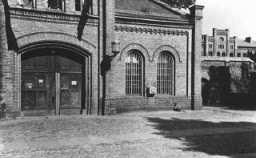
Entrance gate to the Riga ghetto. This photograph was taken from outside the ghetto fence. Riga, Latvia, 1941-1943.
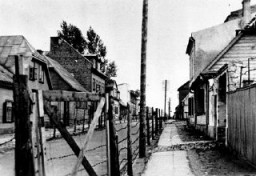
Entrance to the Riga ghetto. Riga, Latvia, 1941–43. During the Holocaust, the creation of ghettos was a key step in the Nazi process of separating, persecuting, and ultimately destroying Europe's Jews.
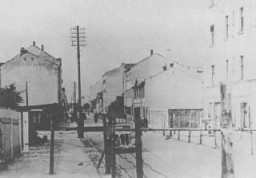
View of a tunnel entrance to the rocket factory at the Dora-Mittelbau concentration camp, near Nordhausen. Germany, April-May 1945.

Entrance to the Warsaw ghetto. The sign states: "Epidemic Quarantine Area: Only Through Traffic is Permitted." Warsaw, Poland, February 1941.

Jewish displaced persons (DPs) enter the main gate of the Ziegenhain DP camp, September 1946.
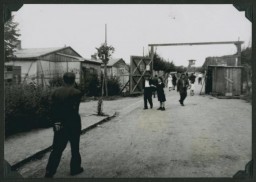
Identification picture of Erich Mühsam taken in the Oranienburg concentration camp. Mühsam, an anarchist and a pacifist, worked as an editor and writer; he was imprisoned during World War I for opposing the war. Arrested during the massive roundup of Nazi political opponents following the Reichstag fire (February 27, 1933), Mühsam was tortured to death in Oranienburg on July 11, 1934. Oranienburg, Germany, February 3, 1934.
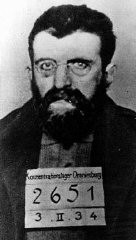
Portrait of Ernest Hemingway by Helen Pierce Breaker. Paris, France, ca. 1928. In 1933, Nazi students at more than 30 German universities pillaged libraries in search of books they considered to be "un-German." Among the literary and political writings they threw into the flames were the works of Ernest Hemingway.
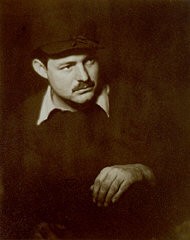
Author Ernest Hemingway aboard the boat Pilar, ca. 1950. In 1933, Nazi students at more than 30 German universities pillaged libraries in search of books they considered to be "un-German." Among the literary and political writings they threw into the flames were the works of Ernest Hemingway.
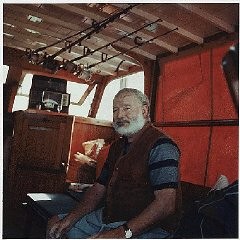
Defendant Ernst Kaltenbrunner during the International Military Tribunal at Nuremberg. He was Chief of the Reich Security Main Office (RSHA) and later Chief of the Security Police.
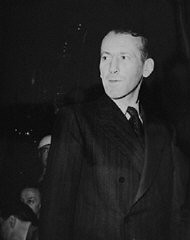
1943 photograph of SS General Ernst Kaltenbrunner, who served as head of the Reich Security Main Office (RSHA) and as chief of Nazi Security Police (Sipo) and the Security Service (SD).
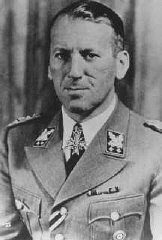
Ernst Toller, German dramatist and revolutionary, emigrated from Germany to other European nations and then to the United States. New York, United States, May 1939.
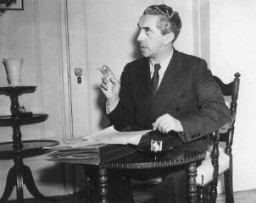
Lieutenant General (later Field Marshal) Erwin Rommel commanded German forces during the campaign in North Africa. Libya, 1941.
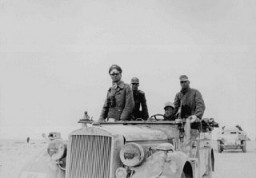
Jewish refugees from France and the Netherlands make their way from France into Spain through a pass in the Pyrenees mountain range. They are being rescued by "Dutch-Paris," an organization created by Seventh-day Adventist Johan Weidner. Ca. 1940.

Establishing racial descent by measuring an ear at the Kaiser Wilhelm Institute for Anthropology. Germany, date uncertain.
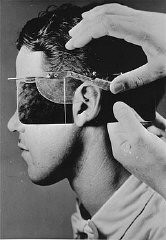
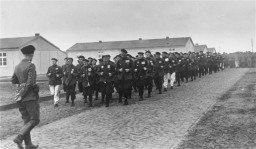
Photograph of Esther Lurie and a friend, Jose, who were both students at the Institute of Art in Brussels. Here they are enjoying refreshments on an outdoor terrace in the early 1930s. Lurie would later flee Europe as war became imminent. Brussels, Belgium, 1931–1933.
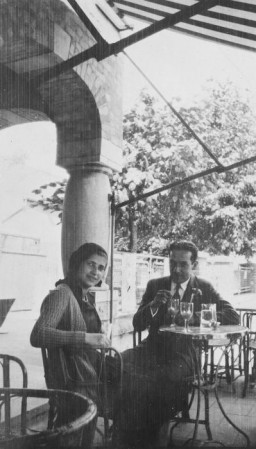
Visitors view the eternal flame in the Hall of Remembrance at the United States Holocaust Memorial Museum.
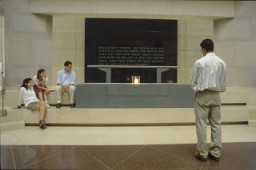
The American Eugenics Society displays an exhibit on health and eugenics at the Kansas Free Fair in 1929.
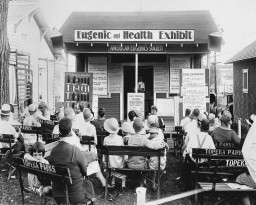
Eugenics poster entitled "The Nuremberg Law for the Protection of Blood and German Honor." The illustration is a stylized map of the borders of central Germany upon which is imposed a schematic of the forbidden degrees of marriage between Aryans and non-Aryans and the text of the Law for the Protection of German Blood. The German text at the bottom reads, "Maintaining the purity of blood insures the survival of the German people."
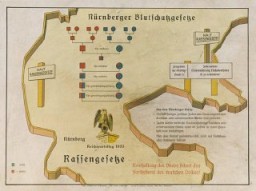
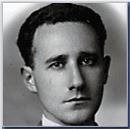
The last group of European Jewish refugees leaves a British detention camp for Israel. Cyprus, February 10, 1949.
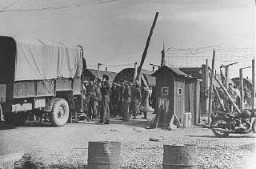
Eva, Alfred, and Leane Munzer. Infant Alfred survived in hiding; his sisters were discovered and killed in Auschwitz.
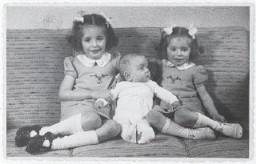
A color photograph of Eva Justin interviewing a Romani woman interned in a "Gypsy camp." Vienna, Austria, 1940. During the Nazi era, Dr. Robert Ritter was a leading authority on the racial classification of people pejoratively labeled “Zigeuner” (“Gypsies”). Ritter’s research was in a field called eugenics, or what the Nazis called “racial hygiene.” Ritter worked with a small team of racial hygienists. Among them were Eva Justin and Sophie Ehrhardt. Most of the people whom Ritter studied and…
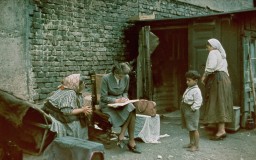
British Zionist leader Norman Bentwich (left) with Henri Berenger, French delegate to the Evian Conference on Jewish refugees. Evian-les-Bains, France, July 1938.

We would like to thank Crown Family Philanthropies, Abe and Ida Cooper Foundation, the Claims Conference, EVZ, and BMF for supporting the ongoing work to create content and resources for the Holocaust Encyclopedia. View the list of donor acknowledgement.